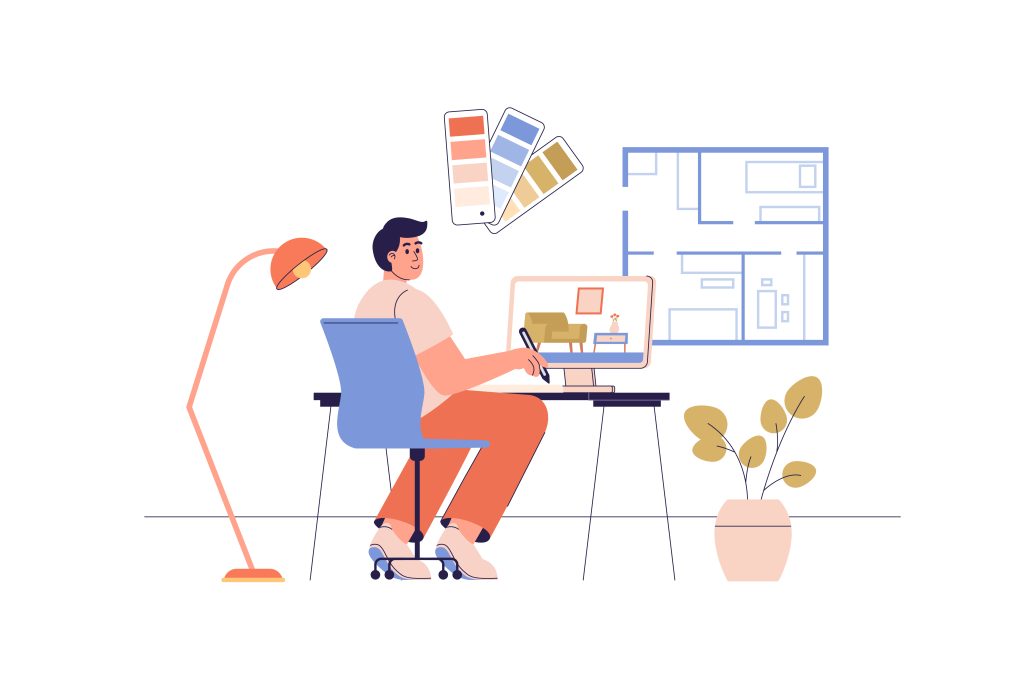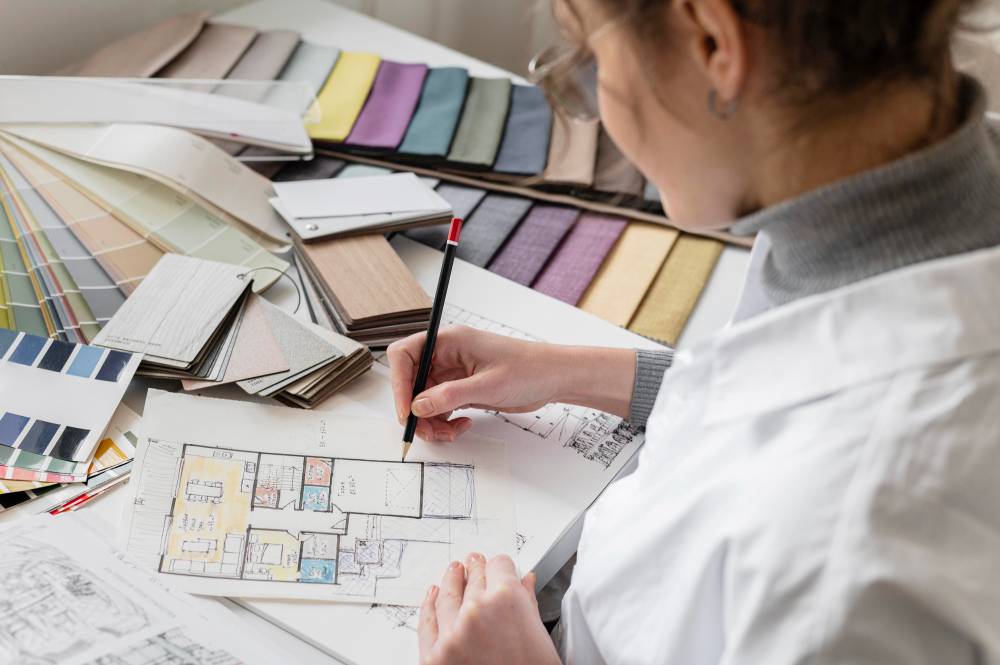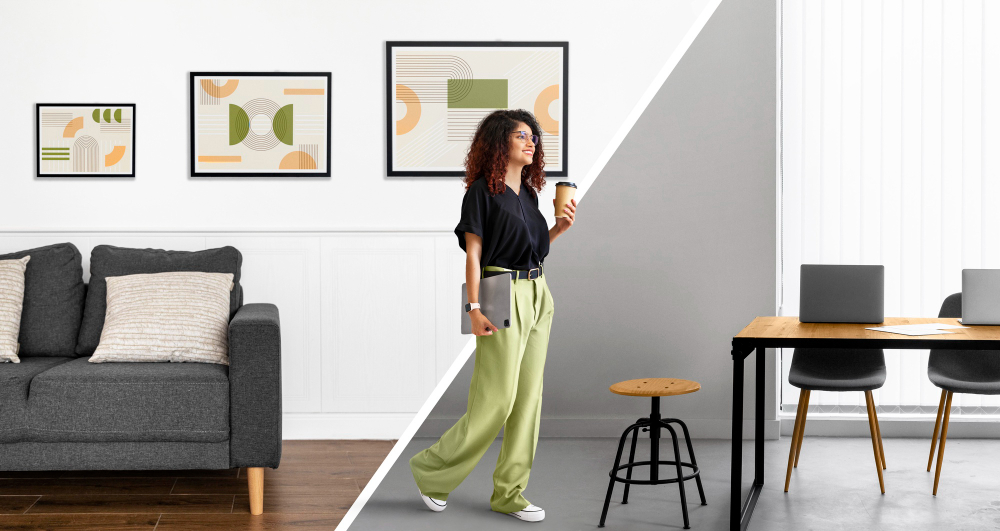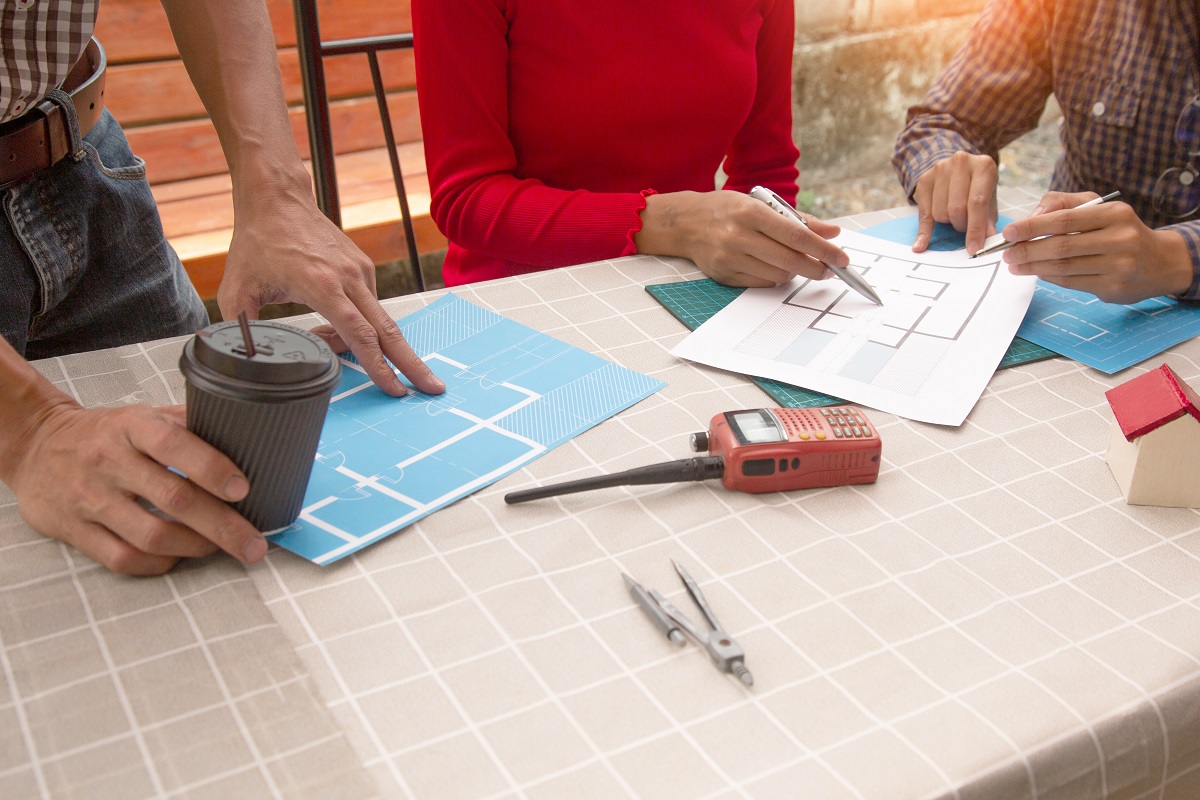Is Interior Design a Good Career? Exploring Salary, Stability, and Challenges
Imagine transforming a simple room into a beautiful, functional space—that’s the power of being an Interior Designer.
In India, Interior Designers can earn around ₹3,50,000 (Glassdoor, 2025) as an average salary. This makes it a rewarding career blending creativity with financial rewards. It’s an ideal path for those who love merging artistic ideas with practical solutions. However, like any other profession, it too comes with its own sets of challenges, such as tight deadlines and managing client expectations.
In this blog, we will explore some of the most popular queries that are trending among aspiring Interior Designers. These include “Is Interior Design a Good Career”, salary potential, job stability, and challenges of Interior Design to help you decide if it’s the right career for you. Let’s get in!
Why Is Interior Design a Good Career Choice
Interior Design offers a diverse array of benefits that make it an appealing choice for many aspirants worldwide. Here are some key reasons why Is Interior Design a Good Career choice:
1. You can express yourself artistically
Do you want free career counseling?
Ignite Your Ambitions- Seize the Opportunity for a Free Career Counseling Session.
- 30+ Years in Education
- 250+ Faculties
- 30K+ Alumni Network
- 10th in World Ranking
- 1000+ Celebrity
- 120+ Countries Students Enrolled
If you have an inclination for beautiful spaces creation, Interior Design can enable the development of your artistic skills. You can choose passion and values-aligned projects, such as eco-friendly designs or non-profit work. This career lets you specialize in your inspired styles or room types.
2. You can choose your own hours
Interior Design offers flexibility in scheduling, especially if you are a freelancer. You can decide how many clients to take on and when to meet them. This flexibility is great for balancing other career opportunities or personal activities.
3. You can select a career path
Interior Design accommodates various educational and professional backgrounds. While there are significant benefits to pursuing your formal education, a strong portfolio can also lead to success. You can empower the growth of your business through referrals and self-promotion, helping to tailor your career to your strengths and interests.
Book Now →
Is Interior Design a Good Paying Job?
Interior Design can be a career with a diverse range of opportunities that are both high-paying and offer a wonderful work-life balance. Here are 12 high-paying Interior Design jobs you must consider, along with their Interior Design Salaries:
1. Visual merchandiser
Visual merchandisers are the core creative minds behind the eye-catching retail shop displays. They help in visual display design and arrangement, considering every detail, from color schemes to lighting and interactive elements. By researching their target market, they plan displays that attract customers and ensure safety while monitoring sales figures.
2. Residential Interior Designer
Residential Interior Designers focus on creating intriguing homely spaces that are both beautiful and functional. They start with a discussion of the client’s needs and then use CAD software to bring their vision to life. Some may have specific rooms or styles specialization, making each project unique and customized to the client’s preferences.
Do you want free career counseling?
Ignite Your Ambitions- Seize the Opportunity for a Free Career Counseling Session.3. Furniture store Interior Designer
These designers work in furniture stores, creating displays that mimic real-life rooms. They help in showroom planning, style- and color-centered group furniture, ensure the safe movement of the inside space, and test the furniture. Their goal is to create spaces that are inviting and inspire customers to envision their home’s furniture.
4. Kitchen designer
Kitchen designers have a deep layout planning, color scheme, and kitchen materials specialization. They ensure that the space is both functional and aesthetically pleasing, and vendors and professionals coordinate, such as plumbers and electricians. Whether you are opting for home designing, restaurants, or industrial kitchens, they create cooking-friendly and comfortable spaces.

5. Educator
Interior Design educators are primarily college, university, or trade association teachers. They lead lectures, grade assignments, and plan curricula, often practicing as designers or conducting research on the trends in the market. They have the inspirational role of educating the subsequent Interior Designer generation.
6. Set designer
Set designers create the films, TV shows, and theater productions’ visual backdrop. They help in script readings, vision discussions with directors, and design sets that bring stories to life. Whether altering spaces that already exist or building new ones, their work is essential to creating immersive audience experiences.
7. Landscape architect
Landscape architects work as a parks, gardens, and campus designers, among other outdoor spaces. For this, they use CAD and GIS software to plan visually pleasing and functional areas. With deep specific space types specializations, they evaluate environmental impacts and perform engineers and architects collaborate to create beautiful outdoor environments.
8. Sustainability consultant
Sustainability consultants focus on creating interiors that are both eco-friendly and aesthetically beautiful. They help with water and energy usage optimization, use environmentally friendly materials, and perform engineers’ collaboration for room sustainability improvement. Their work helps reduce a building’s environmental impact while creating beautiful and functional spaces.
9. Project manager
Project managers oversee the staff and operations for specific projects. They help in schedule development, estimate project costs, and delegate tasks. In Interior Design, they manage designers, engineers, and construction workers, ensuring that projects are timely completed within an allocated budget.
10. Corporate Interior Designer
Corporate Interior Designers work for office space planning for productivity maximization. They incorporate the branding of the company into their designs and create functional and aesthetically pleasing environments for work. They perform client meetings, create sketches, and conduct building code research to ensure that their designs meet all requirements.
11. Healthcare designer
Healthcare designers create hospitals and clinic plans, improving the care of the patients through thoughtful interior layouts. They choose hypoallergenic materials, and perform research, and healthcare and architectural professionals collaborate to create spaces that are both functional and comforting for patients.
12. Accessibility consultant
Accessibility consultants design rooms and buildings that are easy to access for everyone. They create plans for ramps, elevators, and adjustable furniture, ensuring that spaces are inclusive. They work in both the public and private sectors, discussing the needs of the clients and evaluating the costs of the project to create accessible environments.
Disadvantages of Being an Interior Designer
Being an Interior Designer has its own set of challenges. Here are some of the Disadvantages of Being an Interior Designer you might face in this career:
1. Difficult Clients and High Expectations
Client dealing can be tough, especially in the landscape of high expectations and dynamic changes. Effective communication is key, but some clients may push you to adjust budgets and plans frequently. Managing these interactions is a crucial part of the job.
2. Tight Deadlines and Irregular Work Hours
The industry often involves deadlines that are highly tight and time-bound. This can lead to work hours that are long and irregular. One-time Multiple projects balancing can be stressful, making time management skills essential to juggle the demands of work and personal commitments.
3. Physical and Mental Challenges
The job involves physical tasks like visits to the sites, measuring spaces, and handling materials. Mentally, it can be demanding with the constant pressure to create, meet deadlines, and solve unexpected issues. The lack of flexibility in meeting client deadlines can be particularly exhausting.
4. Fluctuations of Income and Financial Challenges
For freelance designers, income can be unpredictable compared to salaried or full-time positions. While experienced designers may have good Interior Design Salaries, those starting out might face uncertain cash flows. Financial management and building a stable client base are crucial to overcoming this challenge.
5. Cost of Materials and Budget Constraints
Material costs can be high, especially when clients have specific requirements that don’t fit the budget. Designers must balance creative ideas with practical budget concerns, ensuring client satisfaction while delivering affordable solutions. This balancing act is a significant part of the designer’s role.
Read Also: Professional Courses After 12th Arts: Top Options, Eligibility, and Career

Key Skills for a Successful Interior Design Career
To succeed in the profession of Interior Design, you will require a robust blend of inherent and developed skills. Here are some key skills that can help you thrive in this creative and dynamic field:
1. Knowledge of Design Trends
Staying current with design trends is important in this ever-evolving and evergreen field. Future trends researching and predicting can make you more desirable to clients. You must be familiarizing yourself with styling elements that are both contemporary and classic and can help you meet a variety of client needs.
2. Technical and Computer Knowledge
Design software systems proficiency can help boost your efficiency and work quality. Computer-aided design (CAD) software, digital imaging tools, and 3D design modeling tools, among other similar tools, can help you create designs that are accurate, printable, and shareable with others. These tools also allow you to better convey your vision to clients.
3. Problem-Solving
Interior Design projects often come with certain unexpected challenges. Problem-solving quickly is essential to keep projects well on track. Whether it’s finding suitable replacements for items that are unavailable or conflict-resolving, it’s important to make logical and rational decisions.
Read Also: Diploma in Interior Designing After 10th: Courses, Fees, and Career
4. Attention to Detail
Focusing on specific details is key to creating designs that are both successful and visually appealing. Time management, organization, and analytical thinking, among other skills, can enhance your noticing ability and address details that are highly intricate in a design.
5. Budgeting
Managing budgets effectively is a vital skill for Interior Designers. You will need to stay within your client’s budget while delivering their design goals. This requires creative problem-solving and strong financial management abilities. Negotiating with your vendors and suppliers can also help minimize costs and allocate resources effectively and efficiently.
6. Creativity
Creativity is at the heart of Interior Design. You will require changes in visualization for the look enhancement and a spacious feel. Color theory, innovative thinking, sketching, and conveying ideas in a clear manner are essential. You must be open-minded and collaborative and can also work in unique and appealing design development.
7. Staying Relevant To Trends
Trends are ever-changing, and courtesy of social media, it’s easier than before to stay in the loop for a long time. For Interior Designers, keeping up with the latest design and industry insights shift is essential. It helps them stay ahead of their client’s expectations and discover new, creative ways to excel in their field.
8. Communication
Effective communication is crucial for Interior Designers. You will often need to be involved in ideas discussions with clients, contractors, and other designers. Clear verbal and written communication combined with active listening and strong presentation skills can help you with client expectations’ understanding and convey your creative vision.
9. Additional Skills
Other useful skills for Interior Designers include communication management, contract creation, facility inspections, networking, stress tolerance, and maintaining a positive attitude. Knowledge of space layout, customer service, construction familiarity, sustainable design, and eco-friendly features can also be beneficial.
Interior Design Salary Insights
If you are thinking about an Interior Design career, it’s important to understand the influences of Interior Design Salaries. Several factors can significantly contribute to your earnings in this field. Let’s dive into these elements and see how they impact your earning potential.
Factors Influence The Interior Designer’s Salary
Numerous elements can influence your Interior Designer’s earning potential. Let’s break them down:
1. Experience
Similar to what goes in any other field, seniority and experience play a big role in an Interior Designer’s salary assessment. Since Interior Design is a client-oriented job, having a strong work history can influence the client’s types and your attracted projects significantly, especially for freelancers and those having their own practice running. This often results in a noticeable difference between the earnings of entry-level designers and experienced designers.
2. Industry and Specialization
Your work in the industry and specialization area can significantly affect your Interior Design Salary. Government or healthcare, among other fields, have strict regulations and compliance requirements, which often mean higher designers’ pay. These projects typically demand more effort and expertise, leading to better compensation.
3. Training and Qualifications
Interior Design isn’t just about space design; it’s about creating environments that meet the needs of both functional and lifestyle-driven people. To do this effectively, designers require knowledge of specialized design principles and proficiency in key software programs.
Read Also: How to Become an Interior Designer: A Step-by-Step Guide
4. Location
Where you work has a major impact on your salary. Your area’s living costs—covering things like rent, food, transport, and energy—affect how high or low salaries are across all industries, including Interior Design. Performing factor research can help you understand the average salaries in your area and set realistic expectations for your earnings.
Interior Design Salary Based On Location
| Location | Average Annual Salary |
| Mumbai | 18T-40T/Month |
| Bengaluru | 20T-35T/Month |
| Pune | 19T-35T/Month |
| New Delhi | 20T-40T/Month |
| Hyderabad | 20T-35T/Month |
| Chennai | 17T-35T/Month |
| Kolkata | 15T-30T/Month |
| Ahmedabad | 15T-30T/Month |
| Noida | 20T-40T/Month |
Reference Source: GlassDoor
Interior Design Salary Based On Experience
| Experience Level | Average Annual Salary |
| Fresher (No Experience) | ₹20T/month |
| Entry Level (1 – 3 Years) | ₹25T/month |
| Intermediate Level (3 – 7 Years) | ₹32.5T/month |
| Senior Level (7 – 10+ Years) | ₹49.83T/month |
Reference Source: GlassDoor
Read Also: The Growing Scope of Interior Design as a Career in 2025
Tips for Aspiring Interior Designers
In the race for academic excellence and personal growth, it is important to adopt strategies that lead to long-term success. Here are 15 tips that can help you succeed:
1. Know the Design History: Clients expect you to know various styles, ranging from Art Deco to modern architecture. Understanding the history of design helps you meet their expectations and create unique, informed designs.
2. Inculcate Spatial Awareness: Successful designers make the most of any space. Experience and creativity help you use space efficiently and functionally.
3. Be Knowledgeable About Sustainability: Great designers integrate eco-friendly practices. Clients increasingly want sustainable features, so stay informed about the latest technologies and methods.
4. Polish Your Communication Skills: You will interact with many people on a project. Good communication ensures everyone remains on the same page.
5. Develop Organizational Skills: Stay organized to meet deadlines and budgets. Efficient organization is key to meeting client expectations.
6. Embrace Diversity: Be open to different styles, even those outside your comfort zone. This flexibility helps you cater to diverse client preferences.
7. Take Inspiration From Everything: Inspiration can come from anywhere. Stay open to new ideas and let your surroundings fuel your creativity.
8. Never Stop Studying: The design field is always evolving. Keep learning to stay ahead and improve your skills.
9. Be Brave: Don’t be afraid to try bold patterns or unexpected color palettes. Courage helps you stand out and lead in the field.
10. Be Patient: Patience is crucial for details like color selection and lighting. Each element affects the overall mood and functionality of a space.
11. Be a Leader: As a project manager, lead your team effectively. Multitask, set boundaries, and lead by example to ensure project success.
12. Embrace Technology: Use the latest tech to enhance your designs. Tools like 3D rendering and Building Information Modelling can improve your work.
13. Go Beyond Design: Be willing to handle various tasks, especially when starting out. Flexibility and a hands-on approach are essential.
14. Set Budgets Without Blocking Creativity: Create budgets that meet client expectations. Communicate clearly if costs need to increase to maintain creativity.
15. Be Prepared for Extended Days: Interior Design requires dedication. Be ready for long hours and adapt to changes to meet project deadlines.
Read Also: Interior Designing Tips for Maximizing Natural Light in Any Space

Frequently Asked Questions
Interior Design is a dynamic and creative field that blends aesthetics with functionality for space transformation. Whether you’re considering an Interior Design career or simply curious about the profession, these FAQs provide valuable insights.
Does Interior Design require maths?
Yes, math is essential for Interior Design, but it’s not as complex as engineering math. Basic math skills are crucial for any successful Interior Designer. Their job involves creating stylish and functional spaces for homes, businesses, and government agencies. Interior Designers transform spaces into welcoming, practical environments.
Is the 12th mark important for Interior Design?
To qualify for an Interior Design course in India, you need to meet certain criteria. If you are considering admission to the Diploma and Degree program, it is typically based on merit or the marks obtained at the 10+2 level from any recognized state or central board in India. You will require a minimum of 50-55 percent marks to be eligible.
Which city is best for Interior Design in India?
Interior Design is a creative field that is focused on designing spaces for a diverse purpose. The best city for Interior Design courses in India depends on your preferences and goals. However, some popular choices include Delhi, Mumbai, Bangalore, and Pune.
Which field is best for Interior Design?
Interior Designers often draw from a variety of disciplines. These include architecture, graphic design, decorative arts, textiles, furniture, and lighting design. A well-rounded education is crucial for developing these skills, enabling designers to create spaces that are both thoughtful and innovative that enhance our lives.
Which course is best for Interior Design after the 12th?
After completing your 12th, you, as an aspiring Interior Designer, can choose from a wide range of courses. These include a B.Des. in Interior Design for a comprehensive program at an undergraduate level, an M.Des. in Interior Design for specialization in an advanced way, and a Diploma in Interior Design for a shorter, skill-focused option, each offering unique goals and duration preference opportunities.
Conclusion
Interior Design goes beyond just a profession; it’s an opportunity to combine creativity, problem-solving, and aesthetic love into a fulfilling career. While it offers both financial rewards and artistic freedom, it also requires adaptability and challenge navigation resilience.
If you are passionate about transforming spaces and willing to embrace the learning curve, Interior Design can be an incredibly rewarding journey for you.
We hope we answer your questions on Is Interior Design a Good Career, Is Interior Design a Good Paying Job, among others? For more information about the Interior Design Courses or if you are looking to enroll in any of our such courses, connect with our AAFT team today!
Always remember, every beautifully designed space starts with a bold idea—why not let yours be the next?

AAFT has been providing the world with limitless creativity and expression since 1993! Through a dynamic and industry-driven curriculum, AAFT provides engaging and captivating articles to persuasive blogs and empowers its readers to explore diverse avenues of creative media education-related content.






